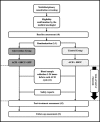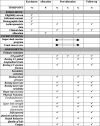Impact of exercise training on cardiotoxicity and cardiac health outcomes in women with breast cancer anthracycline chemotherapy: a study protocol for a randomized controlled trial
- PMID: 31307527
- PMCID: PMC6631879
- DOI: 10.1186/s13063-019-3499-9
Impact of exercise training on cardiotoxicity and cardiac health outcomes in women with breast cancer anthracycline chemotherapy: a study protocol for a randomized controlled trial
Abstract
Background: Anthracyclines are chemotherapeutic agents frequently used in breast cancer (BC) treatment. Although it improves disease-free and overall survival, the use of anthracyclines is associated with a cumulative risk of cardiac toxicity. Preventive strategies to optimize cardiac health are needed and exercise is proposed as a potential non-pharmacological approach for counteracting anthracycline-related cardiotoxicity (ARC). Most of the data on the effects of exercise to reduce ACT are from animal studies, with only a few studies in a limited number of patients indicating beneficial effects. To better understand the effectiveness of exercise in the mitigation of ARC, clinical, real-world trials claim require a larger sample size and more accurate and valuable clinical biomarkers. In this study, we intend to include a large sample and investigate cardiac function through serial measures of biomarkers and imaging techniques.
Methods: This protocol describes a two-arm, prospective, randomized controlled trial that will explore the cardioprotective effect of a structured exercise program in women with BC undergoing anthracycline-containing chemotherapy (ACT). Ninety adult women with early BC and recommended to receive ACT will be randomly assigned (1:1) to an intervention group or a control group. Patients allocated to the intervention group will perform a supervised exercise program three times per week, consisting of a combination of aerobic and resistance training with progressive intensity and volume, during the time period they receive ACT. The control group will receive standard BC care. Primary outcomes related to cardiac (dys)function will be circulating N-terminal pro-brain natriuretic peptide (NT-proBNP) levels, resting left ventricular (LV) longitudinal strain, and resting LV ejection fraction. Secondary outcomes will include the assessment of resting blood pressure, resting heart rate (HR), resting HR variability (HRV), recovery HR, physical function outcomes, self-reported physical activity level, health-related quality of life, and fatigue. Data will be obtained at baseline (t0), after the end of anthracycline-treatment (t2), and 3 months after t2 (t3). Additionally, NT-proBNP will be measured 1-24 h prior to each anthracycline-treatment cycle (t1).
Discussion: The implementation of the present study design, using novel clinical biomarkers, will determine the effect of structured exercise interventions at mitigating ARC, with the overall aim of finding means to further improve BC care.
Trial registration: ISRCTN, ISRCTN32617901 . Registered on 24 October 2018. Last updated on 11 January 2019.
Keywords: Breast cancer; Cardiac healthcare; Cardiotoxicity; Supervised exercise; Supportive cancer care.
Conflict of interest statement
The authors declare that they have no competing interests.
Figures


Similar articles
-
A randomized trial to evaluate the impact of exercise-based cardiac rehabilitation for the prevention of chemotherapy-induced cardiotoxicity in patients with breast cancer: ONCORE study protocol.BMC Cardiovasc Disord. 2021 Apr 7;21(1):165. doi: 10.1186/s12872-021-01970-2. BMC Cardiovasc Disord. 2021. PMID: 33827450 Free PMC article.
-
Rationale and design of the Caloric Restriction and Exercise protection from Anthracycline Toxic Effects (CREATE) study: a 3-arm parallel group phase II randomized controlled trial in early breast cancer.BMC Cancer. 2018 Sep 3;18(1):864. doi: 10.1186/s12885-018-4778-7. BMC Cancer. 2018. PMID: 30176834 Free PMC article. Clinical Trial.
-
Exercise as a diagnostic and therapeutic tool for the prevention of cardiovascular dysfunction in breast cancer patients.Eur J Prev Cardiol. 2019 Feb;26(3):305-315. doi: 10.1177/2047487318811181. Epub 2018 Oct 30. Eur J Prev Cardiol. 2019. PMID: 30376366 Clinical Trial.
-
Rationale and Design of the Cardiac CARE Trial: A Randomized Trial of Troponin-Guided Neurohormonal Blockade for the Prevention of Anthracycline Cardiotoxicity.Circ Heart Fail. 2022 Jul;15(7):e009445. doi: 10.1161/CIRCHEARTFAILURE.121.009445. Epub 2022 Jun 29. Circ Heart Fail. 2022. PMID: 35766037 Review.
-
Anthracycline cardiotoxicity: an update on mechanisms, monitoring and prevention.Heart. 2018 Jun;104(12):971-977. doi: 10.1136/heartjnl-2017-312103. Epub 2017 Dec 7. Heart. 2018. PMID: 29217634 Review.
Cited by
-
Challenges and opportunities for improving cardiovascular health in women with breast cancer: a review.Cardiooncology. 2025 Aug 9;11(1):72. doi: 10.1186/s40959-025-00362-1. Cardiooncology. 2025. PMID: 40783746 Free PMC article. Review.
-
The Beneficial Role of Physical Exercise on Anthracyclines Induced Cardiotoxicity in Breast Cancer Patients.Cancers (Basel). 2022 May 3;14(9):2288. doi: 10.3390/cancers14092288. Cancers (Basel). 2022. PMID: 35565417 Free PMC article. Review.
-
Physical Activity as an Imperative Support in Breast Cancer Management.Cancers (Basel). 2020 Dec 28;13(1):55. doi: 10.3390/cancers13010055. Cancers (Basel). 2020. PMID: 33379177 Free PMC article. Review.
-
Exercise Cardio-Oncology: Exercise as a Potential Therapeutic Modality in the Management of Anthracycline-Induced Cardiotoxicity.Front Cardiovasc Med. 2022 Jan 14;8:805735. doi: 10.3389/fcvm.2021.805735. eCollection 2021. Front Cardiovasc Med. 2022. PMID: 35097024 Free PMC article. Review.
-
A randomized trial to evaluate the impact of exercise-based cardiac rehabilitation for the prevention of chemotherapy-induced cardiotoxicity in patients with breast cancer: ONCORE study protocol.BMC Cardiovasc Disord. 2021 Apr 7;21(1):165. doi: 10.1186/s12872-021-01970-2. BMC Cardiovasc Disord. 2021. PMID: 33827450 Free PMC article.
References
-
- American Cancer Society . Cancer facts & figures 2018. Atlanta: American Cancer Society; 2018.
-
- Armenian SH, Lacchetti C, Barac A, Carver J, Constine LS, Denduluri N, et al. Prevention and monitoring of cardiac dysfunction in survivors of adult cancers: American Society of Clinical Oncology clinical practice guideline. J Clin Oncol. 2017;35(8):893–911. doi: 10.1200/JCO.2016.70.5400. - DOI - PubMed
Publication types
MeSH terms
Substances
Grants and funding
LinkOut - more resources
Full Text Sources
Medical
Molecular Biology Databases
Research Materials

